Antonina's List
By D. T. MAX
Published: September 9, 2007
There were 380,000 Jews in Warsaw on the eve of World War II. Most did not survive the Holocaust. The director of the Warsaw Zoo and his wife were responsible for saving about 300. Why then write about them? Can 300 mean anything when hundreds of thousands died? Certainly any such act of wartime courage is worth recording, but Jan and Antonina Zabinski's work was distinctive. The Nazis dehumanized the Jews; the Zabinskis hid them in animal cages. The Nazis behaved like beasts; the zookeepers, who were experienced with dangerous animals, threw them off the scent with subterfuge and lies. The Zabinskis' effort was not just merciful, it was human in the deepest sense of the word

Jews in Warsaw, 1930s.
THE ZOOKEEPER'S WIFE
By Diane Ackerman.
Illustrated. 368 pp. W. W. Norton & Company. $24.95.
In her poignant new book, Diane Ackerman, the noted nature writer, focuses on Antonina, the "zookeeper's wife" of the title. But her husband, Jan, lived the more dramatic life. He was a lieutenant in the clandestine Polish Army and a professor in Warsaw's secret university. He smuggled Jews out of the Warsaw Ghetto to the zoo. But once there it was up to Antonina to safeguard them: to find them room and food, to keep their spirits up, and most of all to hide them from the Nazis.
"The Zookeeper's Wife" proceeds chronologically, starting before the war, when the Warsaw Zoo was as esteemed as any in Europe. Soon the Nazis destroyed the zoo with bombs and guns. Led by the criminal zoologist Lutz Heck, they carted off the best animals for their own collections. Then Heck and the SS held a shooting festival on New Year's Eve, 1939, to finish the job. Their brutality at the zoo foretold their brutality in the war, as Antonina intuited in her diary, which Ackerman draws on heavily for her book. "How many humans will die like this in the coming months?" Antonina asks herself, watching the Nazi shooting spree.
Soon after they captured Warsaw, the Nazis turned their attention to its Jews, first rounding them up into the ghetto, then shipping them to extermination camps. While the Nazis depopulated the ghetto, the Zabinskis repopulated the zoo - this time with humans. The Nazis had allowed Jan to turn the zoo into a pig farm. So Jan and his staff had reason to enter the ghetto to pick up unused scraps to feed the animals. They brought in tref - nonkosher food - and smuggled out people. More contacts ensued; more pretexts to go into the ghetto; more Jews safeguarded. The Zabinskis hid Jews in sheds, enclosures and even the lion house. Those who had papers or Gentile looks were passed via the underground to other parts of Poland. The rest stayed.
Antonina's own looks helped allay suspicion. Fair and tall, she looked "like a Valkyrie at rest," Ackerman writes. She also had a unique gift, "a nearly shamanistic empathy when it came to animals." Antonina "loved to slip out of her human skin for a while and spy on the world through each animal's eyes." Ackerman's chronicling of this "slippage of the self" forms the freshest part of this book. For Antonina, animal and human formed a continuum. Each of her "guests" was given an animal code name. The distinguished sculptor Magdalena Gross, for instance, was called "starling" because Antonina "pictured her 'flying from nest to nest' to avoid capture." To cheer up her residents, Antonina stocked her "animal republic" with a rabbit named Wicek and a chicken named Jacob and a pet badger who uses Antonina's son's potty. "This house is totally crazy," one mystified resident complains. "You use animal names for people and people's names for animals!"
To fend off cuteness - Herriot's Heroes - Ackerman returns often to the carnage outside the zoo's gates: the routine murder of children, Himmler's determination to destroy every stone in the ghetto as a birthday present for the Führer, the firebombing of entire cities. In 1943, the Allies turned the tide and began driving the Nazis back. The Polish Army rose up in rebellion as the Russian Army, fox-like, waited for the Germans and the Poles to fight to the death. Then they moved in. The zoo reopened in 1949 - with some of its old animals but without its old vigor, and with Stalinism casting a new pall over the grounds. Two years later, Jan resigned as director.
At her lowest moment during the war, Antonina wonders whether the horrible period she was enduring wasn't "a sort of hibernation of the spirit, when ideas, knowledge, science, enthusiasm for work, understanding and love - all accumulate inside" where "nobody can take them from us." Her dream of a Warsaw spring - and a reborn zoo - would come true after the fall of Communism, though she wouldn't live to see it; she died in 1971. Nature is patient, people and animals fundamentally decent, and the writer, as she always does, outlives the killer - that is the message of "The Zookeeper's Wife." This is an absorbing book, diminished sometimes by the choppy way Ackerman balances Antonina's account with the larger story of the Warsaw Holocaust. For me, the more interesting story is Antonina's. She was not, as her husband once called her, "a housewife," but the alpha female in a unique menagerie. I would gladly read another book, perhaps a novel, based again on Antonina's writings. She was special, and as the remaining members of her generation die off, a voice like hers should not be allowed to fade into the silence.
The New York Times
|


 Platform
for Jewish-Polish Dialogue
Platform
for Jewish-Polish Dialogue